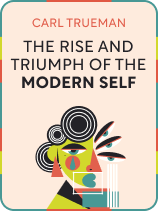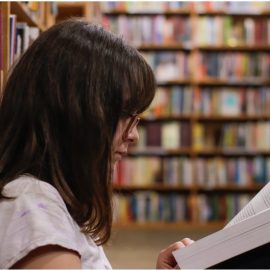

This article is an excerpt from the Shortform book guide to "The Rise and Triumph of the Modern Self" by Carl Trueman. Shortform has the world's best summaries and analyses of books you should be reading.
Like this article? Sign up for a free trial here.
Is there a cultural revolution going on in the West? If so, when and how did it start? What does our sense of self have to do with it?
In The Rise and Triumph of the Modern Self, Carl Trueman argues that cultural developments of the past three centuries have transformed our conception of selfhood. It’s changed from a self rooted in religion, tradition, and community to one rooted in individualism, emotion, and sexuality.
Continue reading for an overview of this thought-provoking book.
Overview of The Rise and Triumph of the Modern Self
Just a few short decades ago, traditional biblical understandings of marriage and gender were considered normal and mainstream throughout Western societies. Most people espoused the view that marriage was a contract between a man and a woman and that gender was inseparable from biologically determined sex.
In The Rise and Triumph of the Modern Self, Carl Trueman, a professor of biblical studies and ecclesiastical history, contends that, not only has mainstream opinion shifted toward the acceptance of gay marriage and transgender identities, but that traditional Christian views have become stigmatized as immoral, irrational, and bigoted. He considers these developments a disaster, as they undermine the traditional Christian morality that formed the foundations of Western culture.
Many consider this to be a sudden shift. However, Trueman asserts that this change wasn’t sudden at all. Instead, it was the culmination of a cultural revolution that has been brewing in Western civilization for centuries. He explains that this revolution began with a changing conception of the self. We’ll explore Trueman’s narrative of this transformation, from the Enlightenment philosophers and the Romantic poets to the LGBTQ+ alliance and the rise of leftist campus activism. Finally, we’ll discuss Trueman’s recommendations for modern-day Christianity.
(Shortform note: The Rise and Triumph of the Modern Self has received mostly positive reviews since its publication in 2020. Critics have praised its depth of research, analytical insight, and relevance to contemporary issues. However, some reviewers have criticized the work as politically one-sided or lacking nuance around LGBTQ+ issues. It’s worth noting that this book has mostly been reviewed in outlets that share Trueman’s socially conservative politics, likely due to its scholarly approach and strong political opinions.)
Part 1: What Is the “Modern” Self?
Before tracing the history of this cultural transformation, let’s establish a foundational understanding of Trueman’s definition of modern selfhood and how it differs from traditional Christian understandings of selfhood. Trueman outlines six characteristics of contemporary selfhood.
1. The modern self is internal. When someone wants to “find themselves,” modern culture encourages them to look inward. Someone finds their “true self” in their deepest feelings and intuitions. This means that selfhood is primarily psychological.
(Shortform note: Popular psychology frequently confirms Trueman’s characterization of how modern people understand selfhood. For example, some experts advise that finding your “true” self requires getting away from other people and going into nature. This view suggests that people are unable to find themselves because of peer pressure and groupthink, confirming the view that your “self” is something deeply internal.)
2. The modern self is expressive. Selves express their emotions, thoughts, and opinions. A well-lived life is an “authentic” life—one in which the individual shares their inner life with others by making it public.
3. The modern self is malleable and determined by the individual. A modern identity is defined by individual choices: where you live, who you associate with, which religions or philosophies you follow, your job, and your hobbies—all of this is up to you. Who “you” are is largely determined by the choices you make.
4. The modern self stands in opposition to social and cultural expectations. When traditional, religious, or institutional authority places restrictions on someone’s behavior or self-expression, this is contrary to their “true self.” To be an authentic self and live a good life is to rebel against traditional authority figures and the restrictions they impose, regardless of the restrictions’ moral content.
5. The modern self is sexual. Trueman argues that modern culture places sexual desires and preferences at the core of selfhood. To live authentically, a modern self must express sexual preferences and find sexual fulfillment.
6. The modern self is free to demand recognition from others. It’s not enough to just express one’s feelings and desires. A modern self can demand that others recognize, affirm, and validate the identity they have chosen for themselves, especially their sexual and gender identity.
(Shortform note: Advice from mental health experts somewhat complicates the objections Trueman raises to modern selfhood, as many mental health experts consider the acceptance and openness of your sexual orientation to be important to your overall mental health. They advise that exploring and understanding your sexuality is a normal part of human development. They also contend that being able to express your sexual identity is important to your sense of self-worth and overall mental health.)
Trueman states that each of these aspects stands in contrast to historical views of selfhood. A “self” was largely determined by external forces when most Europeans worked as peasant farmers, lived in the same town their whole lives, were deeply integrated into extended families, and could not choose their own religions.
| Individualistic and Collectivist Societies Trueman focuses his analysis on the history of the concept of selfhood in Western culture. However, there’s an important contrast to be drawn between modern cultures around the world. Self-expression, self-definition, and opposition to cultural expectations are all values of individualistic cultures as opposed to collectivist cultures. Individualistic cultures are typically found in Western societies like those in Europe and the US. Collectivist cultures are more common in Asia and Africa. Here are some of the key differences. Individualistic cultures tend to value independence and prioritize individual happiness over the well-being of larger groups such as family, community, or nation. People tend to define themselves based on individual traits, such as personalities, talents, and preferences. Collectivist cultures tend to value interdependence over independence. Individuals are expected to sacrifice personal happiness if necessary for the well-being of larger units like family, community, or nation. Furthermore, people in collectivist cultures tend to define themselves based on social roles, such as being a good parent or sibling. |
The Modern Self Stands in Opposition to Christian Teachings
This modern conception of the self inevitably leads to a culture that casts aside Christian views on sexual morality. Trueman explains that traditional Christian teachings hold that human nature is universal and not determined by the individual. It also maintains that sex should only take place in a context of a committed, monogamous marriage. Sex performs a sacred moral purpose of procreation rather than the simple gratification of sexual desire.
Furthermore, Trueman asserts that traditional Christian teachings define marriage as a contract between a man and a woman, barring the possibility of same-sex marriage. Lastly, Christianity holds that a person’s gender is identical to their biological sex, rejecting the possibility of transgender identities.
As we will see, the modern self undermines all of these teachings. It encourages people to pursue sexual desires and identities as an expression of their authenticity while labeling those who would restrict this behavior as oppressors.
Part 2: The Transformation of Selfhood
Trueman states that this modern conception of the self didn’t appear overnight. Rather, it’s the result of three major developments stretching from the 18th to the 20th centuries: promoting the interior self, undermining the traditional view of human nature, and sexualizing selfhood.
Transformation #1: Promoting the Interior Self (18th and Early-19th Centuries)
The transformation into the modern self began with a turn toward focusing on internal experiences rather than external circumstances. Trueman traces two important developments in this history: the philosophy of Jean-Jacques Rousseau and the poetry of the Romantic movement.
1) Rousseau’s Interior Morality
Trueman’s analysis begins with the 18th-century Swiss philosopher Jean-Jacques Rousseau, who elevated the moral status of the inner self. According to Christian traditions, humans are born sinful but become virtuous by following divine morals that are passed on through institutions. In other words, people must learn to be good.
Rousseau argued the opposite: People’s natural moral intuitions are good, but they behave badly because they suppress these intuitions to conform to a corrupt society. Trueman explains that Rousseau’s moral philosophy lays the groundwork for a view that the inner self stands in tension with society, and that, of the two, the inner self is morally superior.
2) The Romantic Poets
Rousseau’s conception of the natural, morally superior inner self was popularized by a movement in 19th-century poetry called Romanticism. The Romantic movement included major poets like William Blake, Samuel Taylor Coleridge, and Percy Bysshe Shelley. Trueman explains that the Romantic poets saw “culture” as something artificial and mannered. They believed that uneducated rural people living rustic lives were more “authentic” and “natural” because they hadn’t assimilated the corrupting influence of culture like educated people in cities.
Because the Romantics were skeptical of the idea that important truths could be found in “culture” or “society,” they elevated emotional and aesthetic experience as a source of higher truth. However, they detached these experiences from any moral framework. This further built the moral authority of the individual against cultural institutions like religion.
Transformation #2: Undermining the Traditional View of Human Nature (Mid-to-Late 19th Century)
While Rousseau and the Romantic poets laid the foundations for the rise of the “emotional and natural inner self,” they still believed in the traditional Christian idea that humans had a fixed and universal nature. The next part of the transformation undermined this view of human nature. Trueman identifies three figures who played a major role in this transition: Charles Darwin, Karl Marx, and Friedrich Nietzsche.
1) Charles Darwin’s Theory of Evolution
Trueman argues that the 19th-century biologist Charles Darwin undermined the Christian view of human nature through his theory of evolution. This theory states that living organisms are shaped by the natural forces of mutation and natural selection and that, through these processes, humans evolved from early primates like apes and monkeys. This challenges the traditional Christian conception of universal human nature in two distinct ways.
- According to Christian tradition, humans are exceptional in nature and created in the image of God. Accepting Darwin’s theory requires a complete revision of humanity’s place in the world. If humans came to exist through impersonal forces that created other plants and animals, then they’re no longer exceptional or created in God’s image.
- According to Christian tradition, humans were created for a unique purpose: to find communion with God by upholding a sacred moral contract. The creation of humans through random or natural forces detaches their nature from this sacred moral purpose.
2) Karl Marx’s Political Selfhood
Trueman asserts that Karl Marx undermined the Christian idea of a universal human nature by placing greater importance on political and economic relationships. A 19th-century German philosopher, Marx proposed radical economic theories that are known today as the foundations of communism.
Marx believed that the upper and lower economic classes exist in a constant power struggle with each other, one in which the lower classes have the moral high ground because they’re economically oppressed. According to this view, the morality or immorality of any human action is determined by which class’s interests are served. This means that the most important thing to understand about a person was neither their inner life nor their moral life, but where they stood in a socioeconomic hierarchy. This view runs contrary to the traditional Christian idea that humans have a universal nature that exists prior to their political and economic relationships with one another. It also downgrades the importance of divine law in evaluating morality.
3) Friedrich Nietzsche’s Individualism
Trueman explains that the 19th-century German philosopher Friedrich Nietzsche also subverted the Christian understanding of a universal human nature with a divine purpose. According to Trueman’s analysis, Nietzsche elevated the authority of the individual by rejecting all external sources of authority for morality or truth.
Nietzsche proclaimed that individuals had the freedom and the responsibility to create truth and morality for themselves. According to this view, there is no such thing as objective truth or morality: Individuals must determine for themselves what is good and bad. This view holds human nature as something that each individual invents, rather than an objective source of truth that holds authority over humanity. This erodes the Christian view of human nature that people were created by God to follow divine moral laws, not to invent their own laws.
Transformation #3: Sexualizing Selfhood (20th Century)
Now that we have established the roots of the interior individual and explored the destabilization of human nature, we can turn our attention to a third component of the modern self: sexuality. In this section, we’ll explore Trueman’s analysis of two important developments in Western thought: how sexuality came to form the center of human identity, and how this sexualized identity was taken up in radical leftist politics.
1) Sigmund Freud’s Theory of Sexual Psychology
The theories of prominent 19th-century psychologist Sigmund Freud brought sexuality to the very center of human identity. Freud posited that sexual impulses form much of the foundation of the unconscious mind. Trueman explains that by placing sexuality at the center of identity, Freud further eroded the authority to restrict sexual behavior. Recall that, according to the modern self, a good life is one where people are able to fulfill their authentic desires. Therefore, if sexuality is at the very center of psychology, then a good life will be one in which sexual desires are fulfilled.
Trueman highlights two areas where Freud’s theories posit sexuality as the center of identity.
1) Genital pleasure: According to Trueman’s analysis, Freud placed sexuality at the core of identity by describing genital pleasure as the psychological blueprint on which all other forms of happiness and satisfaction are modeled. The human mind innately understands sexual pleasure, and therefore other activities are only pleasurable if they provide a psychologically similar experience.
This led Freud to argue that sexual repression was the source of most psychological unhappiness. He saw the restriction of sexuality as a defining feature of civilization and reasoned, therefore, that unhappiness stems from participation in society. This fits neatly with Rousseau’s moral philosophy that society was a source of moral corruption.
2) Sexualizing children: Trueman also states that Freud placed sexuality at the core of human identity by viewing children as inherently sexual. Freud maintained that problems of sexual repression began in early childhood and stemmed from a child’s relationship with their parents. Freudian psychology also sought to reframe childhood masturbation as a medical rather than moral concern. According to this view, children don’t become sexual beings as they enter puberty—they’re always sexual.
2) Freudian Marxism
Trueman explains that, after Freud made identity sexual, 20th-century academics fused Freudian ideas about sexual repression with Marxist notions of class struggle. Recall that Marx saw society as a struggle between an economic elite and an exploited working class. Freudian Marxists added another layer, arguing that economic elites also maintained their power through psychological domination. Therefore, Freudian Marxists sought to identify and overturn this domination. While previous generations of Marxists had focused their attention on property laws and labor contracts, Freudian Marxists focused on how the oppressed classes felt.
Also, recall that Freud posited sexual restriction as a defining feature of civilization. Freudian Marxists began to view sexual restrictions as a form of class domination. In particular, they viewed the traditional patriarchal family as a source of oppression. They argued that traditional families taught people to be obedient to their fathers, which led them to be submissive to economic and political elites. Therefore, to overthrow the oppressive elites, you must first overthrow the traditional family.
3) Separating Sex From Gender
Trueman states the sexual nature of selfhood continued to change as feminists began to separate biological sex from cultural gender. Trueman explains that the traditional Christian understanding of gender holds that it’s determined by biology rather than culture: Someone is born with male or female anatomical parts, and that determines whether they’re male or female.
However, during the 20th century, feminist philosophers began to suggest that while sex may be determined by biology, gender was a social construct and therefore, created by culture. In particular, the feminist Simone de Beauvoir asserts that “woman” is a cultural category that is imposed on people. She argues that women are expected to assimilate into the role of woman. This role, she explained, was not determined by the natural order of the world, but through socially constructed norms and expectations.
Recall that the modern self is at odds with culture and society that restricts its authenticity. By relocating “womanhood” from the “self” to “culture,” Beauvoir places traditional understandings of gender at odds with the interior, authentic self, which is then free to reject the social construct of “womanhood.”
Part 3: The Modern Self Undermines Christian Morality
Now that we have defined the modern self and traced its development over history, we can explore how this transformation has reshaped culture. Trueman asserts that by changing people’s understanding of “selves,” this transformation has impacted society in destructive ways. In this section, we’ll explore two major impacts on modern society: the prioritization of feelings and the rise of the LGBTQ+ movement.
Prioritizing Feelings
Trueman explains that modern selfhood encourages people to place a much greater emphasis on feelings over objective truths, morals, or reasoned arguments. He states that this change in priorities has reshaped society in three distinct ways.
1) Oppression Is a Feeling
Trueman contends that because modern people prioritize feelings, many young people equate feeling discomfort with being oppressed. Recall that Freudian Marxists redefined oppression as psychological domination. Therefore, feeling bad when hearing speech one disagrees with can be framed as a form of oppression. Trueman explains that this tendency is most prevalent in leftist activism on college campuses, where simply expressing traditional points of view is seen as a form of oppression. He contends that this change has rolled back freedom of speech on campuses while undermining the mission of higher education, which includes challenging students’ assumptions.
2) Pornography Is Ubiquitous
Trueman contends that the modern self has paved the way for the widespread acceptance and normalization of pornography. If sexual desires are simply part of an authentic life, then there is very little moral ground to object to fulfilling those desires by consuming pornography. Furthermore, those who object to pornography may be cast as trying to impose a restrictive puritanism on others.
Trueman maintains that pornography is highly destructive to morality. By prioritizing the gratification of the individual consumer, pornography detaches sexuality from its greater moral context of relationships and procreation.
3) Normalization of Abortion
The prioritization of feelings has resulted in a widespread normalization of abortion. Trueman explains this is because the rationale for abortion rests on the well-being of the parents. If a child would make them happy, then they allow it to be born. However, if a child would make the parents unhappy, then it’s acceptable to take the child’s life. Trueman holds that abortion destroys the life of a child and that its widespread normalization devalues human life.
The Rise of the LGBTQ+ Movement
Trueman contends that the rise of the LGBTQ+ movement—a political alliance organized around the interests of gay, lesbian, and transgender people—depends on an understanding of the self that is individually determined, at odds with traditional culture, and highly sexual. Furthermore, Trueman explains that this movement’s aims are opposed to traditional Christian values and destructive to the continuation of Christian culture. In this section, we’ll discuss how the modern self shaped the LGBTQ+ movement, transgender identity, and modern understandings of marriage.
1) The Modern Self Shaped the LGBTQ+ Movement
The modern self played an essential role in forging a political alliance of gays, lesbians, and transgender people. Trueman asserts that these groups aren’t necessarily natural allies.
Furthermore, the identities of gays and lesbians are based on an understanding of gender that contradicts the claims of transgender identity. The defining feature of homosexual identity is an attraction to the same gender. For this to exist, gender needs to be a relatively stable category. Trueman asserts that transgender identity requires the rejection of gender as a stable category. The individual is free to declare themselves a different gender because these categories have no stable or continuous essence.
However, a shared modern understanding of the self brought gays, lesbians, and transgender people together into an alliance. Recall that a modern self places authenticity in tension with society and places sexuality at the core of authenticity. Because each of these groups saw their authentic sexual identities as being in tension with society, this created a shared sense of victimhood that bonded the alliance.
2) The Modern Self Shaped Transgender Identity
Trueman asserts that transgender identities are the product of modern selfhood. To claim that someone’s real gender is the opposite of their biological sex, the internal, feeling self must take priority over external conditions.
Furthermore, a sense of oppression from persecution fundamentally shapes trans identity. Recall that the modern self places authenticity in opposition to culture. Therefore, those who advocate traditional gender identities can be cast as antagonists to authentic selfhood. And because Freudian Marxists defined oppression as psychological, those who reject transgender identities are now widely seen as “oppressors.” Thus, the widespread acceptance of transgender identities in the context of modern selfhood directly leads to the moral stigmatization of traditional Christians.
3) The Modern Self Redefined Marriage
Lastly, Trueman maintains that a redefinition of marriage is an inevitable outcome of the modern conception of selfhood. He makes this case by contrasting traditional Christian marriage with the modern view of marriage.
Traditional Christian marriage fulfills the sacred purpose of creating children and a stable home for them. The modern conception of marriage makes marriage about the emotional fulfillment of the partners getting married. Trueman pushes back on defenders who claim that this is merely an expansion of traditional marriage. Instead, Trueman considers this a destruction of traditional marriage, because this detaches marriage from the sacred moral framework and places it in the framework of the modern, feeling self.
Part 4: Guidelines for Christians Today
Trueman states that his goal is primarily to provide a history of the gradual transformation into modern selfhood rather than a set of guidelines for the present. However, he still offers four recommendations for modern Christians seeking to preserve traditional values.
1. Find inspiration in the second-century Christian church. At this time, Christians were a religious minority living in a powerful empire where Roman authorities viewed Christians with moral suspicion. Nonetheless, Christians thrived as a small community of firm believers who adhered to their religious laws.
2. Prioritize moral laws over aesthetics. Trueman contends that many modern Christians have adopted the modern preoccupation with image and aesthetics to attract followers. Trueman considers this too close to the Romantic poets, who prioritized aesthetics over moral law.
3. Create a strong community. Trueman explains that religions flourish when their members form strong communities. He recommends cultivating stronger ties among religious believers to help Christianity flourish.
4. Recognize the importance of the physical body. Trueman asserts that Christianity cannot allow itself to become detached from the truth that humans were created in God’s image and that Christian commitments require full recognition of the human body’s importance to creation.
Exercise: Reflect on the Ideas in The Rise and Triumph of The Modern Self
This exercise will give you a chance to reflect on the arguments, analysis, and ideas that Trueman presents in The Rise and Triumph of the Modern Self.
- Trueman identifies three major developments in The Rise and Triumph of the Modern Self: promoting the interior self, undermining the traditional view of human nature, and sexualizing selfhood. Of these three, which do you think played the greatest role in shaping contemporary culture and why?
- Trueman presents two conflicting ideas of selfhood. The traditional self is determined by its social context, inherited values, universal human nature, and divinely appointed purpose. The modern self is determined by the individual, found in interior emotions, free from traditional restrictions, and highly sexual. Which view of selfhood do you identify with more, and why?
- Trueman views a permissive attitude toward sexuality as undermining Christian morality and being destructive to society as a whole. Do you agree with these positions? Why or why not?

———End of Preview———
Like what you just read? Read the rest of the world's best book summary and analysis of Carl Trueman's "The Rise and Triumph of the Modern Self" at Shortform.
Here's what you'll find in our full The Rise and Triumph of the Modern Self summary:
- How the modern conception of selfhood has changed over the centuries
- How Christian views have become stigmatized, damaging Western culture
- What modern Christians can do to preserve traditional values






